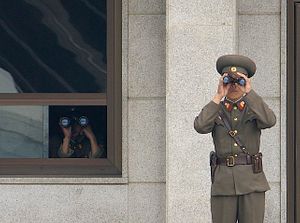A little over two decades ago, early in his tenure as president, Bill Clinton sat in the oval office wrestling with a difficult question: Should the United States conduct a preemptive strike against North Korea in order to head off the country’s pursuit of nuclear weapons? With a little help from Jimmy Carter, the Clinton administration found space for negotiation with then-leader Kim Il-Sung and brokered what came to be known as the Agreed Framework, leading to the diffusion of what would come to be known as Korea’s First Nuclear Crisis.
Over the course of the next two decades, the U.S.-DPRK Agreed Framework has fallen apart and North Korea has resumed its march toward becoming a nuclear power. Today, they’ve almost reached the finish line, though the policy discussions being held in Washington D.C. today are much different than they were back in 1994. Today there is barely a peep about preemptive strikes against North Korea. Instead, the policy consensus has more or less coalesced around the amorphous idea of ‘pressure’ – a hawkish set of policy prescriptions that, when pursued, would force the DPRK to abandon its nuclear weapons and fall in line with its obligations under international law.
Demystifying ‘pressure’ is not necessarily complicated. It almost always boils down to one very specific policy tool: sanctions. Sanctions have been the one policy tool that the U.S. has unambiguously rallied around for the last decade, placing sanctions on the DPRK whenever it commits a nuclear or conventional provocation, and then sanctioning the DPRK again when it fails to modify its behavior.
There is a large and growing body of literature that underscores why sanctions have not and likely will not work in the case of the DPRK. Even if North Korea was a susceptible target for sanctions-induced policy changes, effective sanctions enforcement would rely on full cooperation from the DPRK’s northern neighbors. The history of successes and failures in cooperating with China and Russia on pressuring the DPRK, most recently with the non-enforcement of UN Security Council Resolution 2270, should present a clear lesson: The United States cannot rely on other states with conflicting agendas to further American interests on the Korean peninsula.
The United States’ reliance on sanctions as a policy tool has not just been ineffective, but it is absolutely dangerous. The option of sanctions has created a lazy middle ground for policy hawks to occupy. That middle ground has allowed policy makers to muddle through with inadequate policy instead of confronting head-on the difficult questions that the North Korean nuclear issue poses.
Complicating this policy dilemma is the aversion by policy hawks towards deal-making. Anything resembling engagement is viewed with suspicion, often with firmly held beliefs that the DPRK cannot be trusted to uphold its end of any potential bargains. These concerns are valid, especially as we look back at the history of North Korean deal-making under the leadership of Kim Jong-Il.
Therein, however, lies the tension with the current state of policy towards North Korea. If policy makers are going to reject the idea of negotiations with the DPRK while at the same time acknowledging the fact that sanctions likely will not yield results, then a failure to change those policies is a tacit acceptance of North Korea as a nuclear weapons state. If policy hawks are to continue to dominate the conversation on North Korean policy, then they must be honest in confronting the conclusions that their positions necessarily present: that the United States must decide between bearing the costs of a nuclear-armed North Korea, and bearing the costs of a limited or full scale conflict on the peninsula to eliminate the North Korean nuclear program.
To be clear, this author does not believe that this dilemma between two extreme options exists. Kim Jong-un is not his father, and there are levers that the United States can pull that could lead to negotiations and agreements that could be cautiously and incrementally enforced. The U.S.-ROK military exercises come to mind, as do opportunities for the U.S.-ROK alliance to seek to joint demilitarization at the DMZ. What this author does believe is that policy makers must examine and clarify a strategy on how to move forward on the peninsula – both for themselves and for the international system that they hope to lead.
Three strategic paths forward present themselves: a stability strategy, metered with a premium on medium term stability that would lead in to long term denuclearization; a military strategy, focused on the removal of the North Korean regime or its nuclear capabilities; and a continuation of a do-nothing strategy, complete with all the consequences a nuclear armed DPRK represents. This is the landscape that the United States and its partners face.
Sanctions have not and will not stop the North Korean nuclear program. The United States must stop fooling itself into thinking otherwise.
Travis Lindsay studies international security and economics at UC San Diego’s School of Global Policy & Strategy, where he focuses on Korea issues. He is a member of the Pacific Forum CSIS Young Leaders program and a former intern at the Washington D.C. based Korea Economic Institute of America.

































